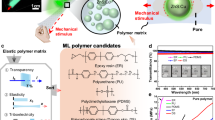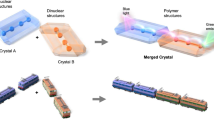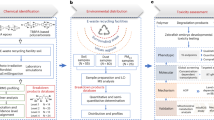Abstract
As mankind continues to extend technological boundaries, sensors must be improved in order to keep pace. The current problem that engineers and scientists face is how to actively monitor structures for damage. One possible method is to embed a triboluminescent material into a composite structure. Nearby sensors would monitor these structures for structural failure or impacts. This paper reports on recently completed research that incorporated the strongly triboluminescent europium dibenzoylmethide triethylammonium (europium tetrakis) into a selection of polymers, such as poly(methyl methacrylate). Additional work was completed to determine if europium tetrakis could be mixed with Cytoseal 60 and 280 to form a durable triboluminescent polymer for small-area sensors. Using a custom-built drop tower, the triboluminescent light yield and decay times was measured for the newly created triboluminescent polymers.
Similar content being viewed by others
Log in or create a free account to read this content
Gain free access to this article, as well as selected content from this journal and more on nature.com
or
References
Olawale, D. O., Dickens, T., Sullivan, W. G., Okoli, O. I., Sobanjo, J. O. & Wang, B. Progress in triboluminescence-based smart optical sensor system. J. Lumin. 131, 1407–1418 (2011).
Childs, P., Wong, A. C., Terry, W. & Peng, G. D. Measurement of crack formation in concrete using embedded optical fibre sensors and differential strain analysis. Meas. Sci. Technol. 19, 65301 (2008).
Chong, K. P., Carino, N. J. & Washer, G. Health monitoring of civil infrastructures. Smart Mater. Struct. 12, 483 (2003).
Merzbacher, C. I., Kersey, A. D. & Friebele, E. J. Fiber optic sensors in concrete structures: a review. Smart Mater. Struct. 5, 196 (1996).
Walton, A. J. Triboluminescence. Adv. Phys. 26, 887–948 (1977).
Chandra, B. Mechanoluminescence. In Luminescence of Solids; Vij D. R. (ed) 361–389 (Plenum Press, New York, NY, 1998).
Chandra, B. P. & Zink, J. I. Triboluminescence and the dynamics of crystal fracture. Phys. Rev. B 21, 816–826 (1980).
Meyer, K., Obrikat, D. & Rossberg, M. Progress in triboluminescence of alkali halides and doped zinc sulphides (I). Krist. Tech. 5, 5–49 (1970).
Sage, I. C. & Bourhill, G. Triboluminescent materials for structural damage monitoring. J. Mater. Chem. 11, 231–245 (2001).
Sage, I. C., Badcock, R., Humberstone, L., Geddes, N. J., Kemp, M. & Bourhill, G. Triboluminescent damage sensors. Smart Mater. Struct. 8, 504 (1999).
Chandra, B. P., Baghel, R. N. & Chandra, V. K. Mechanoluminescence glow curve of ZnS:Mn. Chalcogenide Lett. 7, 1–9 ((2010).
Hollerman, W. A., Fontenot, R. S., Bhat, K. N., Aggarwal, M. D., Guidry, C. J. & Nguyen, K. M. Comparison of triboluminescent emission yields for twenty-seven luminescent materials. Opt. Mater. 34, 1517–1521 (2012).
Sage, I. C., Humberstone, L., Oswald, I., Lloyd, P. & Bourhill, G. Getting light through black composites: embedded triboluminescent structural damage sensors. Smart Mater. Struct. 10, 332–337 (2001).
Sage, I. C. & Geddes, N. J. Triboluminescent Damage Sensors, US Patent US5905260 (1999).
Womack, F. N. Development of a Drop Tower to Study the Triboluminescence of ZnS:Mn with Attention to Possible Applications to Spacecraft ( (University of Louisiana at Lafayette, 2004).
Xu, C. N., Zheng, X. G., Akiyama, M., Nonaka, K. & Watanabe, T. Dynamic visualization of stress distribution by mechanoluminescence image. Appl. Phys. Lett. 76, 179–181 (2000).
Xu, C. N., Watanabe, T., Akiyama, M. & Zheng, X. G. Artificial skin to sense mechanical stress by visible light emission. Appl. Phys. Lett. 74, 1236–1238 (1999).
Fontenot, R. S. & Hollerman, W. A. Measuring the triboluminescence from ZnS:Mn produced by ballistic impacts. J. Instrum. 6, T04001 (2001).
Fontenot, R. S. Measuring the triboluminescent characteristics of ZnS:Mn generated by ballistic impacts. Masters' thesis. (University of Louisiana at Lafayette, 2010).
Dickens, T. J., Breaux, J., Olawale, D. O., Sullivan, W. G. & Okoli, O. I Effects of ZnS:Mn concentrated vinyl ester matrices under flexural loading on the triboluminescent yield. J. Lumin. 132, 1714–1719 (2012).
Hurt, C. R., Mcavoy, N., Bjorklund, S. & Flipescu, N. High intensity triboluminescence in europium tetrakis (dibenzoylmethide)-triethylammonium. Nature 212, 179–180 (1966).
Fontenot, R. S., Hollerman, W. A., Bhat, K. N. & Aggarwal, M. D. Effects of added uranium on the triboluminescent properties of europium dibenzoylmethide triethylammonium. J. Lumin. 134, 477–482 (2013).
Fontenot, R. S., Bhat, K. N., Hollerman, W. A. & Aggarwal, M. D. Triboluminescent materials for smart sensors. Mater. Today 14, 292–293 (2011).
Fontenot, R. S., Hollerman, W. A., Aggarwal, M. D., Bhat, K. N. & Goedeke, S. M. A versatile low-cost laboratory apparatus for testing triboluminescent materials. Measurement 45, 431–436 (2012).
Fontenot, R. S., Hollerman, W. A., Bhat, K. N. & Aggarwal, M. D. Comparison of the triboluminescent properties for europium tetrakis and ZnS:Mn powders. J. Theor. Appl. Phys. 6, 15 (2012).
Fontenot, R. S., Hollerman, W. A., Bhat, K. N. & Aggarwal, M. D. Synthesis and characterization of highly triboluminescent doped europium tetrakis compounds. J. Lumin. 132, 1812–1818 (2012).
Fontenot, R. S., Bhat, K. N., Hollerman, W. A., Aggarwal, M. D. & Nguyen, K. M. Comparison of the triboluminescent yield and decay time for europium dibenzoylmethide triethylammonium synthesized using different solvents. Cryst. Eng. Commun. 14, 1382–1386 (2012).
Fontenot, R. S., Bhat, K. N., Hollerman, W. A. & Aggarwal, M. D. Innovative triboluminescence study of multivitamin doped europium tetrakis. Cryst. Res. Technol. 47, 573–578 (2012).
Bhat, K. N., Fontenot, R. S., Hollerman, W. A. & Aggarwal, M. D. Triboluminescent research review of europium dibenzoylmethide triethylammonium (EUD4TEA) and related materials. Inter. J. Chem. 1, 100–118 (2012).
Fontenot, R. S., Bhat, K. N., Hollerman, W. A. & Aggarwal, M. D. Effects of Dimethyl methylphosphonate on the triboluminescent properties of europium dibenzoylmethide triethylammonium. Sensors & Transducers J. 149, 109–115 (2013).
Mantia, F. L. Handbook of Plastics Recycling, Smithers Rapra Technology, pp 13–15 (2002).
Takada, N., Peng, J. & Minami, N. Relaxation behavior of electroluminescence from europium complex light emitting diodes. Synthetic Met. 121, 1745–1746 (2001).
Fontenot, R. S., Hollerman, W. A., Bhat, K. N., Allison, S. W. & Aggarwal, M. D. Luminescent properties of lanthanide dibenzoylmethide triethylammonium compounds. J. Theo. Appl. Phys. 7, 30 (2013).
Hollerman, W. A., Fontenot, R. S., Bhat, K. N. & Aggarwal, M. D. Measuring the process variability in triboluminescence emission yield for EuD4TEA. Metall. Mater. Trans. A 43, 4200–4203 (2012).
Acknowledgements
This research was funded in part by NASA Alabama Space Grant Consortium fellowship under Training Grant NNX10AJ80H, NSF-RISE Project HRD 0927644, and other grants from the State of Louisiana and Federal agencies. One of the authors (MDA) thanks UNCF special programs corporation for the NASA Science and Technology Institute (NSTI) research cluster project for their support.
Author information
Authors and Affiliations
Corresponding author
Rights and permissions
About this article
Cite this article
Fontenot, R., Hollerman, W., Bhat, K. et al. Incorporating strongly triboluminescent europium dibenzoylmethide triethylammonium into simple polymers. Polym J 46, 111–116 (2014). https://doi.org/10.1038/pj.2013.78
Received:
Revised:
Accepted:
Published:
Issue date:
DOI: https://doi.org/10.1038/pj.2013.78
Keywords
This article is cited by
-
Mechanoluminescence of metal complexes: Progress and applications
Journal of Central South University (2023)
-
Advances in triboluminescence and mechanoluminescence
Journal of Materials Science: Materials in Electronics (2019)
-
Effective photosensitized, electrosensitized, and mechanosensitized luminescence of lanthanide complexes
NPG Asia Materials (2018)



